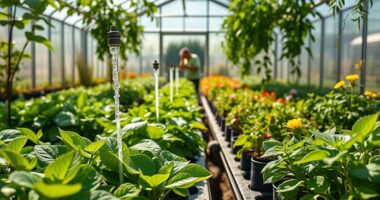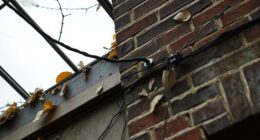To efficiently collect rainwater in your greenhouse, install gutters made of durable materials like aluminum or vinyl that slope properly for ideal flow. Position downspouts to direct water away from the foundation using splash blocks or extensions. Incorporate filters such as mesh screens to keep debris out and maintain cleaner water. Proper sealing and secure brackets prevent leaks, ensuring long-term performance. Keep an eye on your system’s maintenance, and you’ll discover even more ways to enhance water collection and sustainability.
Key Takeaways
- Install durable, seamless gutters with proper slope to ensure efficient rainwater collection and minimize leaks.
- Use effective filters and leaf guards to prevent debris from contaminating stored rainwater.
- Strategically position downspouts to direct water away from the greenhouse foundation and prevent erosion.
- Regularly maintain and clean gutter components to ensure optimal water flow and system longevity.
- Incorporate splash blocks or extensions to disperse water safely and protect greenhouse structures.

Implementing an effective gutter system for rainwater collection can considerably enhance your greenhouse’s sustainability and water efficiency. When designed properly, your gutter system captures rainwater directly from the roof, reducing reliance on external water sources and lowering your utility bills. To maximize these benefits, focus on proper rainwater filtration and employ effective gutter installation techniques that ensure durability and ideal water flow.
Rainwater filtration is a critical element in maintaining clean, safe water for your greenhouse plants. As rainwater flows through your gutters, it can pick up debris, leaves, dust, and other contaminants. Installing a simple yet effective filtration system at the gutter’s entry point can prevent these impurities from entering your storage tanks. You might consider mesh screens, leaf guards, or specialized filters that block larger debris while allowing water to pass freely. Regular maintenance of these filters is essential to keep water quality high and prevent clogs. Additionally, using fine mesh screens over downspouts can further improve rainwater quality and reduce sediment buildup in your storage tanks.
Rainwater filters protect tank quality by trapping debris and ensuring safe, clean water for your greenhouse.
Gutter installation techniques play a vital role in ensuring your rainwater collection system operates efficiently. Start by choosing the right materials—galvanized steel, aluminum, or high-quality vinyl are popular options due to their resistance to corrosion and durability. When installing, ensure your gutters are sloped correctly, typically about 1/4 inch for every 10 feet, to facilitate proper water runoff toward the downspouts. Proper placement and securing of brackets are crucial; they should be firmly attached to prevent sagging or detachment during heavy rains. Seamless gutters or continuous systems minimize leaks and reduce maintenance needs over time. When connecting gutters to downspouts, make sure all joints are sealed tightly to prevent leaks and ensure smooth water flow.
Position your downspouts strategically to direct water away from your greenhouse foundation, preventing erosion or water damage. Installing splash blocks or flexible extensions can help disperse water farther from your structure. During installation, take care to inspect the entire system for potential leak points and ensure all components are tightly secured. Proper gutter installation not only enhances rainwater collection but also minimizes the risk of overflow or water pooling, which could compromise your greenhouse’s structural integrity. Additionally, understanding the principles of proper water flow can help optimize the system’s efficiency and longevity.
Frequently Asked Questions
How Do Gutter Systems Prevent Algae Growth in Collected Rainwater?
To prevent algae growth in collected rainwater, you should focus on algae prevention by keeping your gutters clean and ensuring good water flow. Regular gutter treatment helps inhibit algae development by reducing nutrients that promote growth. You can also add a UV filter or use opaque storage tanks to block sunlight, which discourages algae from thriving. Consistent maintenance keeps your rainwater clear and algae-free for healthier greenhouse use.
What Materials Are Best for Gutter Durability in Greenhouse Environments?
You might think metal gutters are the best, but investigate further—materials like aluminum and vinyl actually offer superior durability in greenhouse environments. Aluminum provides excellent corrosion resistance and long-lasting material longevity, making it ideal for wet conditions. Vinyl gutters are also highly resistant to corrosion and require minimal maintenance. Both options protect your rainwater system from rust and deterioration, ensuring your gutters stay functional and reliable over time.
How Often Should Gutter Systems Be Maintained or Cleaned?
You should clean your gutter system at least twice a year, but the gutter cleaning frequency may increase if your greenhouse is nearby trees or experiences heavy rainfall. Regular maintenance schedules help prevent clogs, mold, and water damage. Check for debris and buildup every few months, especially after storms. Keeping gutters clear guarantees efficient rainwater collection and prolongs their lifespan, safeguarding your greenhouse’s structure and plants.
Can Gutter Systems Be Integrated With Automated Watering Systems?
Yes, you can integrate gutter systems with automated watering systems. Use rainwater filtration to guarantee clean water delivery, and consider gutter shading to prevent debris buildup. Connecting sensors and timers allows precise control, optimizing water use for your greenhouse. This integration helps maintain healthy plants, reduces manual effort, and promotes efficient resource management, making your greenhouse more sustainable and easier to operate.
What Are the Costs Associated With Installing a Gutter System in a Greenhouse?
Installing a gutter system in your greenhouse typically costs between $500 and $2,500, depending on size and materials. A detailed cost estimation helps you plan effectively. The installation process involves attaching gutters to the roof, connecting downspouts, and ensuring proper drainage. While initial costs vary, a well-installed system can save you money long-term by reducing water bills and promoting sustainable practices in your greenhouse.
Conclusion
Now that you’ve explored gutter systems for rainwater collection, imagine each drop as a tiny messenger bringing fresh life to your greenhouse. When you harness this gift from the sky, you turn your structure into a thriving oasis, where every droplet nourishes your plants and nurtures your dreams. Embrace this rainwater bounty, and watch your greenhouse flourish like a lush, green symphony—nature’s song played perfectly through your clever gutter system.









